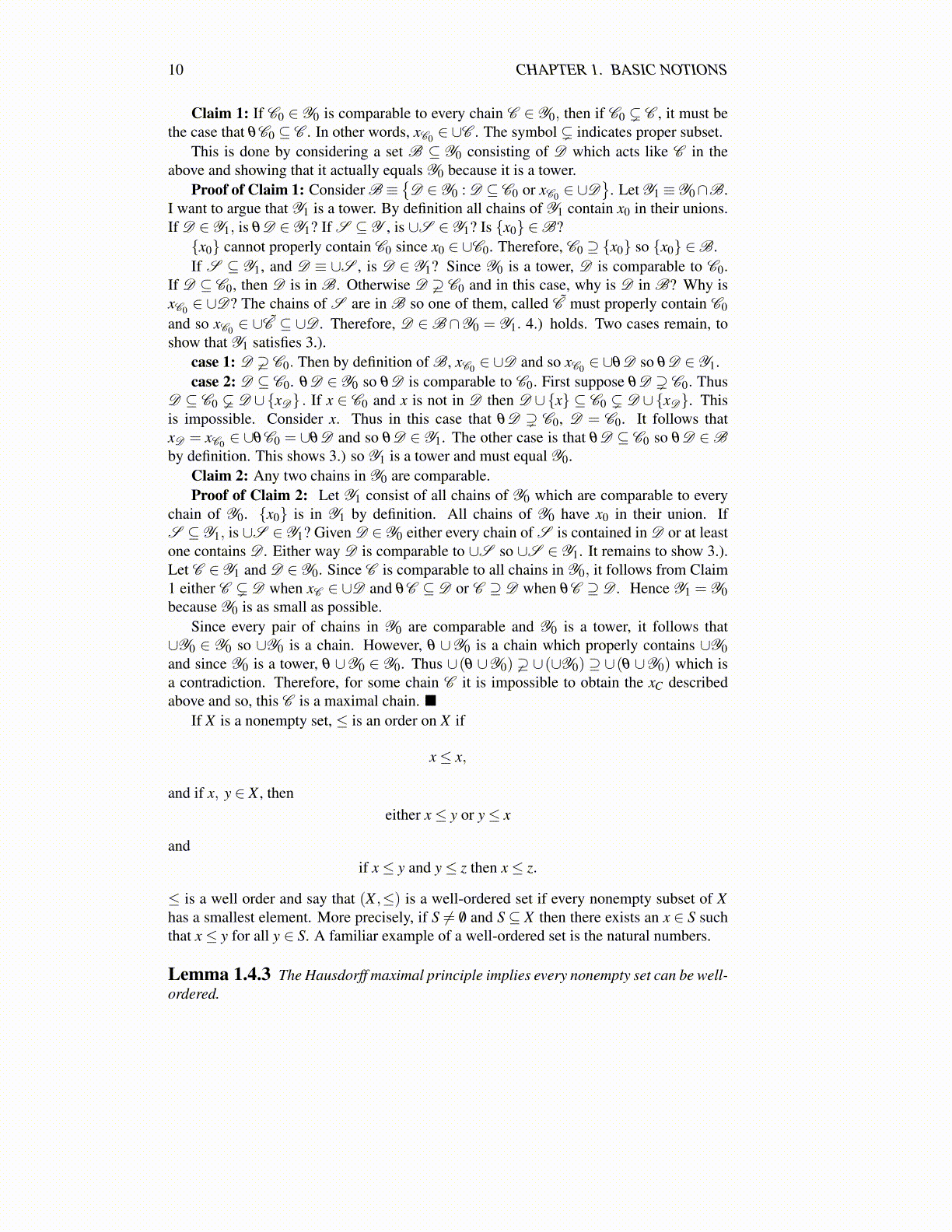
10 CHAPTER 1. BASIC NOTIONS
Claim 1: If C0 ∈ Y0 is comparable to every chain C ∈ Y0, then if C0 ⊊ C , it must bethe case that θC0 ⊆ C . In other words, xC0 ∈ ∪C . The symbol ⊊ indicates proper subset.
This is done by considering a set B ⊆ Y0 consisting of D which acts like C in theabove and showing that it actually equals Y0 because it is a tower.
Proof of Claim 1: Consider B ≡{D ∈ Y0 : D ⊆ C0 or xC0 ∈ ∪D
}. Let Y1 ≡Y0∩B.
I want to argue that Y1 is a tower. By definition all chains of Y1 contain x0 in their unions.If D ∈ Y1, is θD ∈ Y1? If S ⊆ Y , is ∪S ∈ Y1? Is {x0} ∈B?{x0} cannot properly contain C0 since x0 ∈ ∪C0. Therefore, C0 ⊇ {x0} so {x0} ∈B.If S ⊆ Y1, and D ≡ ∪S , is D ∈ Y1? Since Y0 is a tower, D is comparable to C0.
If D ⊆ C0, then D is in B. Otherwise D ⊋ C0 and in this case, why is D in B? Why isxC0 ∈ ∪D? The chains of S are in B so one of them, called C̃ must properly contain C0
and so xC0 ∈ ∪C̃ ⊆ ∪D . Therefore, D ∈B∩Y0 = Y1. 4.) holds. Two cases remain, toshow that Y1 satisfies 3.).
case 1: D ⊋ C0. Then by definition of B, xC0 ∈ ∪D and so xC0 ∈ ∪θD so θD ∈ Y1.case 2: D ⊆ C0. θD ∈ Y0 so θD is comparable to C0. First suppose θD ⊋ C0. Thus
D ⊆ C0 ⊊ D ∪{xD} . If x ∈ C0 and x is not in D then D ∪{x} ⊆ C0 ⊊ D ∪{xD}. Thisis impossible. Consider x. Thus in this case that θD ⊋ C0, D = C0. It follows thatxD = xC0 ∈ ∪θC0 = ∪θD and so θD ∈ Y1. The other case is that θD ⊆ C0 so θD ∈Bby definition. This shows 3.) so Y1 is a tower and must equal Y0.
Claim 2: Any two chains in Y0 are comparable.Proof of Claim 2: Let Y1 consist of all chains of Y0 which are comparable to every
chain of Y0. {x0} is in Y1 by definition. All chains of Y0 have x0 in their union. IfS ⊆Y1, is ∪S ∈Y1? Given D ∈Y0 either every chain of S is contained in D or at leastone contains D . Either way D is comparable to ∪S so ∪S ∈ Y1. It remains to show 3.).Let C ∈ Y1 and D ∈ Y0. Since C is comparable to all chains in Y0, it follows from Claim1 either C ⊊ D when xC ∈ ∪D and θC ⊆ D or C ⊇ D when θC ⊇ D . Hence Y1 = Y0because Y0 is as small as possible.
Since every pair of chains in Y0 are comparable and Y0 is a tower, it follows that∪Y0 ∈ Y0 so ∪Y0 is a chain. However, θ ∪Y0 is a chain which properly contains ∪Y0and since Y0 is a tower, θ ∪Y0 ∈ Y0. Thus ∪(θ ∪Y0) ⊋ ∪(∪Y0) ⊇ ∪(θ ∪Y0) which isa contradiction. Therefore, for some chain C it is impossible to obtain the xC describedabove and so, this C is a maximal chain. ■
If X is a nonempty set, ≤ is an order on X if
x≤ x,
and if x, y ∈ X , theneither x≤ y or y≤ x
andif x≤ y and y≤ z then x≤ z.
≤ is a well order and say that (X ,≤) is a well-ordered set if every nonempty subset of Xhas a smallest element. More precisely, if S ̸= /0 and S ⊆ X then there exists an x ∈ S suchthat x≤ y for all y ∈ S. A familiar example of a well-ordered set is the natural numbers.
Lemma 1.4.3 The Hausdorff maximal principle implies every nonempty set can be well-ordered.